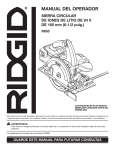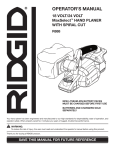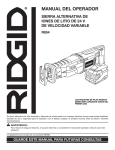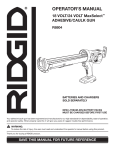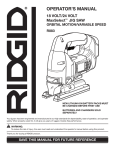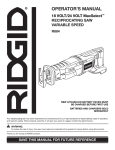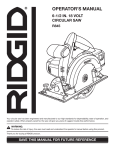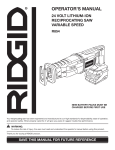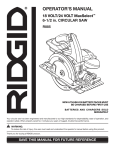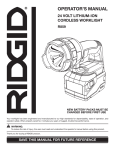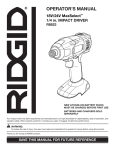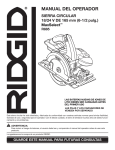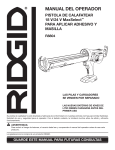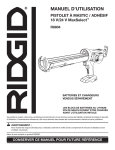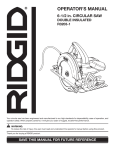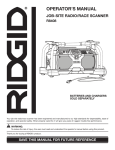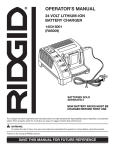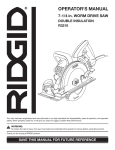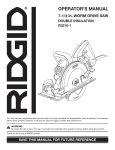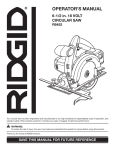Download RIDGID R855 User's Manual
Transcript
OPERATOR’S MANUAL 24 VOLT LITHIUM-ION 6-1/2 in. CIRCULAR SAW R855 8 7 6 5 4 0 50 5 0 NEW BATTERY PACKS MUST BE CHARGED BEFORE FIRST USE Your circular saw has been engineered and manufactured to our high standards for dependability, ease of operation, and operator safety. When properly cared for, it will give you years of rugged, trouble-free performance. WARNING: To reduce the risk of injury, the user must read and understand the operator’s manual before using this product. Thank you for buying a RIDGID product. SAVE THIS MANUAL FOR FUTURE REFERENCE 1 TABLE OF CONTENTS Introduction .......................................................................................................................................................................2 General Safety Rules ..................................................................................................................................................... 3-4 Specific Safety Rules ..................................................................................................................................................... 4-5 Safety Rules for Charger ...................................................................................................................................................6 Symbols ......................................................................................................................................................................... 7-8 Features ....................................................................................................................................................................... 9-10 Assembly ................................................................................................................................................................... 10-11 Operation ................................................................................................................................................................... 12-21 Maintenance ................................................................................................................................................................... 22 Warranty ......................................................................................................................................................................... 23 Customer Service Information ........................................................................................................................................ 24 INTRODUCTION This tool has many features for making its use more pleasant and enjoyable. Safety, performance, and dependability have been given top priority in the design of this product making it easy to maintain and operate. WARNING: Some dust created by power sanding, sawing, grinding, drilling, and other construction activities contains chemicals known to cause cancer, birth defects or other reproductive harm. Some examples of these chemicals are: • lead from lead-based paints, • crystalline silica from bricks and cement and other masonry products, and • arsenic and chromium from chemically-treated lumber. Your risk from these exposures varies, depending on how often you do this type of work. To reduce your exposure to these chemicals: work in a well ventilated area, and work with approved safety equipment, such as those dust masks that are specially designed to filter out microscopic particles. 2 GENERAL SAFETY RULES Use safety equipment. Always wear eye protection. Safety equipment such as dust mask, non-skid safety shoes, hard hat, or hearing protection used for appropriate conditions will reduce personal injuries. Avoid accidental starting. Ensure the switch is in the off-position before plugging in. Carrying power tools with your finger on the switch or plugging in power tools that have the switch on invites accidents. Remove any adjusting key or wrench before turning the power tool on. A wrench or a key left attached to a rotating part of the power tool may result in personal injury. Do not overreach. Keep proper footing and balance at all times. This enables better control of the power tool in unexpected situations. Dress properly. Do not wear loose clothing or jewelry. Keep your hair, clothing and gloves away from moving parts. Loose clothes, jewelry or long hair can be caught in moving parts. If devices are provided for the connection of dust extraction and collection facilities, ensure these are connected and properly used. Use of these devices can reduce dust-related hazards. Do not wear loose clothing or jewelry. Contain long hair. Loose clothes, jewelry, or long hair can be drawn into air vents. Do not use on a ladder or unstable support. Stable footing on a solid surface enables better control of the power tool in unexpected situations. WARNING! Read all instructions. Failure to follow all instructions listed below may result in electric shock, fire and/or serious injury. The term “power tool” in all of the warnings listed below refers to your mains-operated (corded) power tool or battery-operated (cordless) power tool. SAVE THESE INSTRUCTIONS WORK AREA SAFETY Keep work area clean and well lit. Cluttered or dark areas invite accidents. Do not operate power tools in explosive atmospheres, such as in the presence of flammable liquids, gases or dust. Power tools create sparks which may ignite the dust or fumes. Keep children and bystanders away while operating a power tool. Distractions can cause you to lose control. ELECTRICAL SAFETY Power tool plugs must match the outlet. Never modify the plug in any way. Do not use any adapter plugs with earthed (grounded) power tools. Unmodified plugs and matching outlets will reduce risk of electric shock. Avoid body contact with earthed or grounded surfaces such as pipes, radiators, ranges and refrigerators. There is an increased risk of electric shock if your body is earthed or grounded. POWER TOOL USE AND CARE Do not expose power tools to rain or wet conditions. Water entering a power tool will increase the risk of electric shock. Do not force the power tool. Use the correct power tool for your application. The correct power tool will do the job better and safer at the rate for which it was designed. Do not use the power tool if the switch does not turn it on and off. Any power tool that cannot be controlled with the switch is dangerous and must be repaired. Disconnect the plug from the power source and/or the battery pack from the power tool before making any adjustments, changing accessories, or storing power tools. Such preventive safety measures reduce the risk of starting the power tool accidentally. Store idle power tools out of the reach of children and do not allow persons unfamiliar with the power tool or these instructions to operate the power tool. Power tools are dangerous in the hands of untrained users. Maintain power tools. Check for misalignment or binding of moving parts, breakage of parts and any other condition that may affect the power tool’s operation. If damaged, have the power tool repaired before use. Many accidents are caused by poorly maintained power tools. Keep cutting tools sharp and clean. Properly maintained cutting tools with sharp cutting edges are less likely to bind and are easier to control. Do not abuse the cord. Never use the cord for carrying, pulling or unplugging the power tool. Keep cord away from heat, oil, sharp edges or moving parts. Damaged or entangled cords increase the risk of electric shock. When operating a power tool outdoors, use an extension cord suitable for outdoor use. Use of a cord suitable for outdoor use reduces the risk of electric shock. Use battery only with charger listed. MODEL R855 BATTERY PACK 130377001 (R85008) CHARGER 140315001 (R85009) PERSONAL SAFETY Stay alert, watch what you are doing and use common sense when operating a power tool. Do not use a power tool while you are tired or under the influence of drugs, alcohol or medication. A moment of inattention while operating power tools may result in serious personal injury. 3 GENERAL SAFETY RULES Use the power tool, accessories and tool bits etc., in accordance with these instructions and in the manner intended for the particular type of power tool, taking into account the working conditions and the work to be performed. Use of the power tool for operations different from those intended could result in a hazardous situation. connection from one terminal to another. Shorting the battery terminals together may cause burns or a fire. Under abusive conditions, liquid may be ejected from the battery, avoid contact. If contact accidentally occurs, flush with water. If liquid contacts eyes, additionally seek medical help. Liquid ejected from the battery may cause irritation or burns. BATTERY TOOL USE AND CARE SERVICE Ensure the switch is in the off position before inserting battery pack. Inserting the battery pack into power tools that have the switch on invites accidents. Recharge only with the charger specified by the manufacturer. A charger that is suitable for one type of battery pack may create a risk of fire when used with another battery pack. Use power tools only with specifically designated battery packs. Use of any other battery packs may create a risk of injury and fire. When battery pack is not in use, keep it away from other metal objects like paper clips, coins, keys, nails, screws, or other small metal objects that can make a Have your power tool serviced by a qualified repair person using only identical replacement parts. This will ensure that the safety of the power tool is maintained. WARNING! To reduce the risk of injury, user must read instruction manual. When servicing a power tool, use only identical replacement parts. Follow instructions in the Maintenance section of this manual. Use of unauthorized parts or failure to follow Maintenance instructions may create a risk of shock or injury. SPECIFIC SAFETY RULES Do not crush, drop or damage battery pack. Do not use a battery pack or charger that has been dropped or received a sharp blow. A damaged battery is subject to explosion. Properly dispose of a dropped or damaged battery immediately. If the power supply cord is damaged, it must be replaced only by the manufacturer or by an authorized service center to avoid risk. DANGER! Keep hands away from cutting area and the blade. Keep your second hand on auxiliary handle or motor housing. If both hands are holding the saw, they cannot be cut by the blade. � Do not reach underneath the workpiece. The guard cannot protect you from the blade below the workpiece. � Adjust the cutting depth to the thickness of the workpiece. Less than a full tooth of the blade teeth should be visible below the workpiece. Never hold piece being cut in your hands or across your leg. Secure the workpiece to a stable platform. It is important to support the work properly to minimize body exposure, blade binding, or loss of control. � Hold tool by insulated gripping surfaces when performing an operation where the cutting tool may contact hidden wiring or its own cord. Contact with a “live” wire will make exposed metal parts of the tool “live” and shock the operator. CAUSES AND OPERATOR PREVENTION OF KICKBACK: Kickback is a sudden reaction to a pinched, bound, or misaligned saw blade, causing an uncontrolled saw to lift up and out of the workpiece toward the operator. When the blade is pinched or bound tightly by the kerf closing down, the blade stalls and the motor reaction drives the unit rapidly back toward the operator. If the blade becomes twisted or misaligned in the cut, the teeth at the back edge of the blade can dig into the top surface of the wood causing the blade to climb out of the kerf and jump back toward the operator. Kickback is the result of saw misuse and/or incorrect operating procedures or conditions and can be avoided by taking proper precautions, as given below: � When ripping, always use a rip fence or straight edge guide. This improves the accuracy of cut and reduces the chance of blade binding. � Always use blades with correct size and shape (diamond versus round) of arbor holes. Blades that do not match the mounting hardware of the saw will run eccentrically, causing loss of control. Never use damaged or incorrect blade washers or bolt. The blade washers and bolt were specially designed for your saw for optimum performance and safety of operation. Maintain a firm grip with both hands on the saw and position your arms to resist kickback forces. Position your body to either side of the blade, but not in line with the blade. Kickback could cause the saw to jump backwards, but kickback forces can be controlled by the operator, if proper precautions are taken. 4 SPECIFIC SAFETY RULES � When blade is binding, or when interrupting a cut for any reason, release the trigger and hold the saw motionless in the material until the blade comes to a complete stop. Never attempt to remove the saw from the work or pull the saw backward while the blade is in motion, or kickback may occur. Investigate and take corrective actions to eliminate the cause of blade binding. � When restarting a saw in the workpiece, center the saw blade in the kerf and check that saw teeth are not engaged into the material. If saw blade is binding, it may walk up or kickback from the workpiece as the saw is restarted. � Support large panels to minimize the risk of blade pinching and kickback. Large panels tend to sag under their own weight. Supports must be placed under the panel on both sides, near the line of cut and near the edge of the panel. Do not use dull or damaged blades. Unsharpened or improperly set blades produce narrow kerf causing excessive friction, blade binding and kickback. � Blade depth and bevel adjusting locking levers must be tight and secure before making cut. If blade adjustment shifts while cutting, it may cause binding and kickback. � Use extra caution when making a “plunge cut” into existing walls or other blind areas. The protruding blade may cut objects that can cause kickback. Always wear safety glasses with side shields. Everyday glasses have only impact resistant lenses. They are NOT safety glasses. Following this rule will reduce the risk of eye injury. � Protect your lungs. Wear a face or dust mask if the operation is dusty. Following this rule will reduce the risk of serious personal injury. � Protect your hearing. Wear hearing protection during extended periods of operation. Following this rule will reduce the risk of serious personal injury. � Battery tools do not have to be plugged into an electrical outlet; therefore, they are always in operating condition. Be aware of possible hazards when not using your battery tool or when changing accessories. Following this rule will reduce the risk of electric shock, fire, or serious personal injury. ADDITIONAL SAFETY RULES Check damaged parts. Before further use of the tool, a guard or other part that is damaged should be carefully checked to determine that it will operate properly and perform its intended function. Check for alignment of moving parts, binding of moving parts, breakage of parts, mounting, and any other conditions that may affect its operation. A guard or other part that is damaged should be properly repaired or replaced by an authorized service center. Following this rule will reduce the risk of shock, fire, or serious injury. Inspect for and remove all nails from lumber before using this tool. Following this rule will reduce the risk of serious personal injury. Do not operate tool while under the influence of drugs, alcohol, or any medication. Following this rule will reduce the risk of electric shock, fire, or serious personal injury. Do not place battery tools or their batteries near fire or heat. This will reduce the risk of explosion and possibly injury. Batteries vent hydrogen gas and can explode in the presence of a source of ignition, such as a pilot light. To reduce the risk of serious personal injury, never use any cordless product in the presence of open flame. An exploded battery can propel debris and chemicals. If exposed, flush with water immediately. Do not charge battery tool in a damp or wet location. Following this rule will reduce the risk of electric shock. For best results, your battery tool should be charged in a location where the temperature is more than 50°F but less than 100°F. Do not store outside or in vehicles. Under extreme usage or temperature conditions, battery leakage may occur. If liquid comes in contact with your skin, wash immediately with soap and water, then neutralize with lemon juice or vinegar. If liquid gets into your eyes, flush them with clean water for at least 10 minutes, then seek immediate medical attention. Following this rule will reduce the risk of serious personal injury. Check lower guard for proper closing before each use. Do not operate saw if lower guard does not move freely and close instantly. Never clamp or tie the lower guard into the open position. If saw is accidentally dropped, lower guard may be bent. Raise the lower guard with the retracting handle. Make sure it moves freely and does not touch the blade or any other part, in all angles and depths of cut. � Check the operation of the lower guard spring. If the guard and the spring are not operating properly, they must be serviced before use. Lower guard may operate sluggishly due to damaged parts, gummy deposits, or a buildup of debris. � Lower guard should be retracted manually only for special cuts, such as “plunge cuts” and “compound cuts.” Raise lower guard by retracting handle. As soon as blade enters the material, the lower guard must be released. For all other sawing, the lower guard should operate automatically. Always observe that the lower guard is covering the blade before placing saw down on bench or floor. An unprotected, coasting blade will cause the saw to walk backwards, cutting whatever is in its path. Be aware of the time it takes for the blade to stop after switch is released. Know your power tool. Read operator’s manual carefully. Learn its applications and limitations, as well as the specific potential hazards related to this power tool. Following this rule will reduce the risk of electric shock, fire, or serious injury. 5 SAFETY RULES FOR CHARGER An extension cord should not be used unless absolutely necessary. Use of improper extension cord could result in a risk of fire and electric shock. If extension cord must be used, make sure: a. That pins on plug of extension cord are the same number, size and shape as those of plug on charger. b. That extension cord is properly wired and in good electrical condition; and c. That wire size is large enough for AC ampere rating of charger as specified below: Cord Length (Feet) 25' 50' 100' Cord Size (AWG) 16 16 16 NOTE: AWG = American Wire Gauge Do not operate charger with a damaged cord or plug, which could cause shorting and electric shock. If damaged, have the charger replaced by an authorized serviceman. Do not operate charger if it has received a sharp blow, been dropped, or otherwise damaged in any way. Take it to an authorized serviceman for electrical check to determine if the charger is in good working order. Do not disassemble charger. Take it to an authorized serviceman when service or repair is required. Incorrect reassembly may result in a risk of electric shock or fire. Unplug charger from outlet before attempting any maintenance or cleaning to reduce the risk of electric shock. Disconnect charger from the power supply when not in use. This will reduce the risk of electric shock or damage to the charger if metal items should fall into the opening. It also will help prevent damage to the charger during a power surge. Risk of electric shock. Do not touch uninsulated portion of output connector or uninsulated battery terminal. Save these instructions. Refer to them frequently and use them to instruct others who may use this tool. If you loan someone this tool, loan them these instructions also to prevent misuse of the product and possible injury. WARNING! READ AND UNDERSTAND ALL INSTRUCTIONS. Failure to follow all instructions listed below, may result in electric shock, fire and/or serious personal injury. Before using battery charger, read all instructions and cautionary markings in this manual, on battery charger, battery, and product using battery to prevent misuse of the products and possible injury or damage. CAUTION: To reduce the risk of electric shock or damage to the charger and battery, charge only lithium-ion rechargeable batteries as specifically designated on your charger. Other types of batteries may burst, causing personal injury or damage. Do not use charger outdoors or expose to wet or damp conditions. Water entering charger will increase the risk of electric shock. Use of an attachment not recommended or sold by the battery charger manufacturer may result in a risk of fire, electric shock, or injury to persons. Following this rule will reduce the risk of electric shock, fire, or serious personal injury. Do not abuse cord or charger. Never use the cord to carry the charger. Do not pull the charger cord rather than the plug when disconnecting from receptacle. Damage to the cord or charger could occur and create an electric shock hazard. Replace damaged cords immediately. Make sure cord is located so that it will not be stepped on, tripped over, come in contact with sharp edges or moving parts or otherwise subjected to damage or stress. This will reduce the risk of accidental falls, which could cause injury, and damage to the cord, which could result in electric shock. Keep cord and charger from heat to prevent damage to housing or internal parts. Do not let gasoline, oils, petroleum-based products, etc. come in contact with plastic parts. They contain chemicals that can damage, weaken, or destroy plastic. IMPORTANT SAFETY INSTRUCTIONS 1. SAVE THESE INSTRUCTIONS 2. 3. This manual contains important safety and operating instructions for battery charger 140315001. Before using battery charger, read all instructions and cautionary markings on battery charger, battery, and product using battery. CAUTION: To reduce the risk of injury, charge only lithium-ion rechargeable batteries. Other types of batteries may burst, causing personal injury or damage. 6 SYMBOLS Some of the following symbols may be used on this tool. Please study them and learn their meaning. Proper interpretation of these symbols will allow you to operate the tool better and safer. SYMBOL NAME DESIGNATION/EXPLANATION V Volts Voltage A Amperes Current Hz Hertz Frequency (cycles per second) W Watt Power Minutes Time Alternating Current Type of current Direct Current Type or a characteristic of current No Load Speed Rotational speed, at no load Class II Construction Double-insulated construction Per Minute Revolutions, strokes, surface speed, orbits etc., per minute Wet Conditions Alert Do not expose to rain or use in damp locations. Read The Operator’s Manual To reduce the risk of injury, user must read and understand operator’s manual before using this product. Eye Protection Always wear safety goggles or safety glasses with side shields and, as necessary, a full face shield when operating this product. Safety Alert Precautions that involve your safety. No Hands Symbol Failure to keep your hands away from the blade will result in serious personal injury. No Hands Symbol Failure to keep your hands away from the blade will result in serious personal injury. No Hands Symbol Failure to keep your hands away from the blade will result in serious personal injury. No Hands Symbol Failure to keep your hands away from the blade will result in serious personal injury. Hot Surface To reduce the risk of injury or damage, avoid contact with any hot surface. min no .../min 7 SYMBOLS The following signal words and meanings are intended to explain the levels of risk associated with this product. SYMBOL SIGNAL MEANING DANGER: Indicates an imminently hazardous situation, which, if not avoided, will result in death or serious injury. WARNING: Indicates a potentially hazardous situation, which, if not avoided, could result in death or serious injury. CAUTION Indicates a potentially hazardous situation, which, if not avoided, may result in minor or moderate injury. CAUTION (Without Safety Alert Symbol) Indicates a situation that may result in property damage. SERVICE WARNING: Servicing requires extreme care and knowledge and should be performed only by a qualified service technician. For service we suggest you return the product to your nearest AUTHORIZED SERVICE CENTER for repair. When servicing, use only identical replacement parts. To avoid serious personal injury, do not attempt to use this product until you read thoroughly and understand completely the operator’s manual. If you do not understand the warnings and instructions in the operator’s manual, do not use this product. Call RIDGID customer service for assistance. WARNING: The operation of any power tool can result in foreign objects being thrown into your eyes, which can result in severe eye damage. Before beginning power tool operation, always wear safety goggles or safety glasses with side shields and, when needed, a full face shield. We recommend Wide Vision Safety Mask for use over eyeglasses or standard safety glasses with side shields. Always use eye protection which is marked to comply with ANSI Z87.1. SAVE THESE INSTRUCTIONS 8 FEATURES PRODUCT SPECIFICATIONS Blade Diameter .......................................................6-1/2 in. Blade Arbor ............................................................... 5/8 in. Cutting Depth at 0º.................................................2-1/8 in. Cutting Depth at 45º...............................................1-5/8 in. BATTERY PACK Motor .................................................................. 24 Volt DC Charger Input ................................... 120 V, 60 Hz, AC only Speed .................................................... 3,900 r/min. (RPM) SWITCH TRIGGER LOCK-OFF BUTTON SPINDLE LOCK BUTTON HEX KEY STORAGE 8 7 6 5 4 0 50 5 0 DEPTH ADJUSTMENT LEVER EDGE GUIDE BEVEL ADJUSTMENT LEVER 50° ADJUSTMENT BUTTON WIDTH OF CUT SCALE 4-1/8 in. CHARGER Fig. 1 9 FEATURES KNOW YOUR CIRCULAR SAW EDGE GUIDE See Figure 1. The safe use of this product requires an understanding of the information on the tool and in this operator’s manual as well as a knowledge of the project you are attempting. Before use of this product, familiarize yourself with all operating features and safety rules. The edge guide is used when making long or wide rip cuts with the saw. 50° ADJUSTMENT BUTTON The 50° adjustment button provides more flexibility while cutting by allowing an extra 5° to the bevel adjustment lever. HEX KEY STORAGE BEVEL ADJUSTMENT LEVER Conveniently stores your hex key for quick blade changes. The bevel adjustment lever allows you to set the circular saw for bevel cuts from 45° to 90°. LOCK-OFF BUTTON The lock-off button reduces the possibility of accidental starting. CHARGER Your charger has a “key hole” hanging feature for convenient, space saving storage. Screws should be installed so that the center distance is 4-1/8 in. SPINDLE LOCK BUTTON The spindle lock button allows you to secure the blade when turning the blade screw. DEPTH ADJUSTMENT LEVER WIDTH OF CUT SCALE The depth adjustment lever adjusts the depth of cut from 0 in. to 2-1/8 in. When making straight cross cuts or rip cuts, the scale can be used to measure up to 4 in. on the right side of the blade, and up to 1 in. on the left side of the blade. ASSEMBLY UNPACKING This product requires assembly. WARNING: Carefully remove the tool and any accessories from the box. Make sure that all items listed in the packing list are included. If any parts are damaged or missing do not operate this tool until the parts are replaced. Failure to heed this warning could result in serious personal injury. Inspect the tool carefully to make sure no breakage or damage occurred during shipping. Do not discard the packing material until you have carefully inspected and satisfactorily operated the tool. WARNING: Do not attempt to modify this tool or create accessories not recommended for use with this tool. Any such alteration or modification is misuse and could result in a hazardous condition leading to possible serious personal injury. If any parts are damaged or missing, please call 1-866-539-1710 for assistance. PACKING LIST 6-1/2 in. Circular Saw Charger Battery Pack Saw Blade WARNING: Hex Key To prevent accidental starting that could cause serious personal injury, always remove the battery pack from the tool when assembling parts. Edge Guide Tool Bag Operator’s Manual 10 ASSEMBLY ATTACHING THE BLADE See Figure 2. SPINDLE LOCK BUTTON INNER BLADE WASHER WARNING: A 6-1/2 in. blade is the maximum blade capacity of the saw. Never use a blade that is too thick to allow outer blade washer to engage with the flats on the spindle. Larger blades will come in contact with the blade guard, while thicker blades will prevent blade screw from securing blade on spindle. Either of these situations could result in a serious accident. 0 50 5 Remove the battery pack from the saw. Remove the hex key from the storage area. Depress the spindle lock button and remove the blade screw and outer blade washer. BLADE BLADE SCREW NOTE: Turn the blade screw counterclockwise to remove. OUTER BLADE WASHER Fig. 2 CAUTION: To prevent damage to the spindle or spindle lock, always allow motor to come to a complete stop before engaging spindle lock. SPINDLE LOCK BUTTON Wipe a drop of oil onto the inner blade washer and outer blade washer where they contact the blade. WARNING: If inner blade washer has been removed, replace it before placing blade on spindle. Failure to do so could cause an accident since blade will not tighten properly. 5 0 50 Fit the saw blade inside the lower blade guard and onto the spindle. HEX KEY NOTE: The saw teeth point upward at the front of the saw. TO TIGHTEN Replace the outer blade washer. Depress the spindle lock button, then replace the blade screw. Tighten the blade screw securely. TO LOOSEN NOTE: Turn the blade screw clockwise to tighten. Fig. 3 Return hex key to storage area. NOTE: Never use a blade that is too thick to allow the outer blade washer to engage with the flats on the spindle. REMOVING THE BLADE See Figure 3. Remove the battery pack from saw. Remove the hex key from the storage area. Position the saw as shown, depress the spindle lock button, and remove the blade screw. NOTE: Turn blade screw counterclockwise to remove. Remove the outer blade washer. Remove the blade. 11 OPERATION CHARGE LEVEL INDICATOR WARNING: Do not allow familiarity with tools to make you careless. Remember that a careless fraction of a second is sufficient to inflict severe injury. 24vXLi ? WARNING: Always wear safety goggles or safety glasses with side shields when operating tools. Failure to do so could result in objects being thrown into your eyes resulting in possible serious injury. WARNING: Do not use any attachments or accessories not recommended by the manufacturer of this tool. The use of attachments or accessories not recommended can result in serious personal injury. APPLICATIONS You may use this tool for the purposes listed below: Cutting all types of wood products (lumber, plywood, paneling) Cross cutting/Rip cutting Bevel cutting Pocket cutting Fig. 4 NOTE: The use of abrasive cut-off wheels is not recommended for this saw. CHARGING THE BATTERY PACK NOTE: New 24 Volt lithium-ion battery packs will not work without first being charged. Before first time use, charge the battery pack to activate it. CAUTION: It is not necessary to drain the battery pack completely before recharging. Lithium-ion battery packs have no “memory” and can be recharged at any time. It is therefore possible to charge the battery pack before extended usage even if the battery pack is not completely drained of charge. Use the charge level indicator to determine the amount of charge in the battery pack. If at any point during the charging process none of the LEDs are lit, remove the battery pack from the charger to avoid damaging the product. DO NOT insert another battery. Return the charger and battery to your nearest service center for service or replacement. Lithium-ion batteries deliver fade free power for their entire run time. 24 Volt lithium-ion tools will not gradually lose power due to decreasing battery charge. Instead, power from the battery pack will drop from full to zero once the full charge has been drained from the battery. Once this happens, your tool’s power drops from full to zero, and recharging the battery is required. CAUTION: Charge in a well ventilated area. Do not block charger vents. Keep them clear to allow proper ventilation. 12 OPERATION CHARGING A HOT BATTERY PACK TO CHARGE If the battery pack is above normal temperature range, the red LED will begin flashing and the green LED will be off. When the battery pack cools down to approximately 150°F (65°C), the charger will automatically begin fast charge mode. A fully discharged battery pack with a temperature between 32°F (0°C) and 150°F (65°C) will charge in about an hour. Charge the 24 Volt lithium-ion battery pack only with the charger provided. � Connect the charger to a power supply. NOTE:iIf needed, the charger can operate with most generators and inverters rated at 300 Watts or higher. Attach the battery pack to the charger by aligning the raised ribs on the battery pack with the grooves in the charger, then slide the battery pack onto the charger. See Figure 4. Do not place the charger in an area of extreme heat or cold. It will work best at normal room temperature. After charging is complete, the continuous green light will come on and the charge level indicator lights on the battery will go off. The charger will keep the battery pack fully charged if left on the charger. NOTE: Refer to CHARGING THE BATTERY PACK for normal recharging of batteries. If the charger does not charge the battery pack under normal circumstances, return both the battery pack and charger to your nearest repair center for electrical check. For the location of your nearest repair center, please call 1-866-539-1710. CHARGING A COOL BATTERY PACK If the battery pack is below normal temperature range, the red LED will begin flashing and the green LED will be off. When the battery warms to a temperature of more than 14°F (-10°C), the charger will automatically begin charging. COLD WEATHER OPERATION The lithium-ion battery pack can be used in temperatures down to -4°F (-20°C). When the battery pack is very cold, it may “buzz” for the first minute of use to warm itself up. Put the battery pack on a tool and use the tool in a light duty application. After about a minute, the pack will have warmed itself up and begin operating normally. 13 OPERATION LED FUNCTION OF CHARGER See Figure 5. LED INDICATOR BATTERY PACK RED LED GREEN LED ACTION Charging Fast charging ON OFF Charges in 1 hour Charging Deeply Discharged ON OFF Charger pre-charges battery until normal voltage is reached, then begins fast charge mode. May take longer than 1 hour to fully charge. Full Maintenance charging OFF ON Fast charging is complete Charger maintains charge mode Evaluate Hot battery pack Flashing OFF When battery pack reaches cooled temperature, charger begins fast charge mode Evaluate Cold battery pack Flashing OFF When battery pack reaches warmed temperature, charger begins fast charge mode Defective Defective Flashing Flashing Battery pack or charger is defective • If defective, try to repeat the conditions a second time by removing and reinstalling the battery pack. If the LED status repeats a second time, try charging a different battery. • If a different battery charges normally, dispose of the defective pack (see Maintenance section). • If a different battery also indicates “Defective,” the charger may be defective. FULL CAPACITY RED LED GREEN LED 1/2 CAPACITY CHARGING INDICATOR 3/4 CAPACITY 24vXLi ? FULL INDICATOR 1/4 CAPACITY EVALUATE INDICATOR CHARGE LEVEL INDICATOR CHARGE LEVEL INDICATOR BUTTON Fig. 6 CHARGE LEVEL INDICATOR DEFECTIVE INDICATOR See Figure 6. The charge level indicator shows that the battery is charged at 1/4, 1/2, 3/4, or full capacity. To display the amount of charge left in the battery, press and hold the charge level indicator button. NOTE: When the battery pack contains less than 10% charge, the 1/4 charge level indicator will flash. Fig. 5 14 OPERATION TO INSTALL BATTERY PACK See Figure 7. Place the battery pack in the saw. Align the raised rib inside the saw with the groove on the battery pack. Make sure the latches on each side of the battery pack snap in place and the battery pack is secured in the saw before beginning operation. TO INSTALL TO REMOVE CAUTION: When placing battery pack in the tool, be sure raised rib on battery pack aligns with the groove inside the tool and latches into place properly. Improper installation of the battery pack can cause damage to internal components. 24 vX RAISED RIB Li TO REMOVE BATTERY PACK ? See Figure 7. Locate latches on the side of the battery pack and depress to release the battery pack from the saw. DEPRESS LATCHES TO RELEASE BATTERY PACK Remove the battery pack from the saw. SAW BLADES Fig. 7 LOWER BLADE GUARD IS IN UP POSITION WHEN MAKING A CUT The best of saw blades will not cut efficiently if they are not kept clean, sharp, and properly set. Using a dull blade will place a heavy load on the saw and increase the danger of kickback. Keep extra blades on hand, so that sharp blades are always available. Gum and wood pitch hardened on blades will slow the saw down. Use gum and pitch remover, hot water, or kerosene to remove these accumulations. DO NOT USE GASOLINE. BLADE GUARD SYSTEM See Figure 8. The lower blade guard attached to your cordless circular saw is there for your protection and safety. It should never be altered for any reason. If it becomes damaged or begins to return slow or sluggish, do not operate the saw until the damage has been repaired or replaced. Always leave guard in operating position when using saw. BLADE EXPOSED ON UNDERSIDE OF WORKPIECE DANGER: When sawing through workpiece, lower blade guard does not cover blade on the underside of workpiece. Since blade is exposed on underside of workpiece, keep hands and fingers away from cutting area. Any part of your body coming in contact with moving blade will result in serious injury. Fig. 8 CAUTION: Never use saw when guard is not operating correctly. Check the guard for correct operation before each use. The guard is operating correctly when it moves freely and readily returns to the closed position. If you drop the saw, check the lower blade guard and bumper for damage at all depth settings before reuse. 15 OPERATION KICKBACK - BLADE SET TOO DEEP KICKBACK See Figures 9 - 12. Kickback occurs when the blade stalls rapidly and the saw is driven back towards you. Blade stalling is caused by any action which pinches the blade in the wood. WARNING: To avoid kickback, release switch trigger immediately if blade binds or saw stalls. Kickback could cause you to lose control of the saw. Loss of control can lead to serious injury. Fig. 9 INCORRECT SUPPORT To guard against kickback, avoid dangerous practices such as the following. Setting blade depth incorrectly Sawing into knots or nails in workpiece Twisting the blade while making a cut Making a cut with a dull, gummed up, or improperly set blade Supporting the workpiece incorrectly Forcing a cut Cutting warped or wet lumber WRONG Fig. 10 Operating the tool incorrectly or misusing the tool CORRECT BLADE DEPTH SETTING = BLADE EXPOSED 1/4 in. MAX OR LESS ON UNDERSIDE OF WORKPIECE To lessen the chance of kickback, follow these safety practices. Keep the blade at the correct depth setting. The depth setting should not exceed 1/4 in. below the material being cut. Inspect the workpiece for knots or nails before cutting. Never saw into a knot or nail. Make straight cuts. Always use a straight edge guide when rip cutting. This helps prevent twisting the blade. Use clean, sharp, and properly set blades. Never make cuts with dull blades. Support the workpiece properly before beginning a cut. Use steady, even pressure when making a cut. Never force a cut. 1/4 in. MAX Do not cut warped or wet lumber. Hold the saw firmly with both hands and keep your body in a balanced position so as to resist the forces if kickback should occur. Fig. 11 CORRECT SUPPORT WARNING: When using the saw, always stay alert and exercise control. Do not remove the saw from the workpiece while the blade is moving. Fig. 12 16 OPERATION LOCK-OFF BUTTON LOCK-OFF BUTTON See Figure 13. The lock-off button reduces the possibility of accidental starting. The lock-off button is located on the handle above the switch trigger. The lock-off button must be depressed before you pull the switch trigger. NOTE: You can depress the lock-off button from either the left or right side. STARTING/STOPPING THE SAW See Figure 13. To start the saw: Depress the lock-off button. Depress the switch trigger. SWITCH TRIGGER Always let the blade reach full speed, then guide the saw into the workpiece. DEPTH ADJUSTMENT LEVER If the blade comes in contact with the workpiece before it reaches full speed, it could cause the saw to “kickback” towards you, which could result in serious injury. 50 5 0 WARNING: Fig. 13 INDICATOR POINT To stop the saw, release the switch trigger. After you release the switch trigger, allow the blade to come to a complete stop. Do not remove the saw from the workpiece while the blade is moving. SCALE DEPTH OF CUT ADJUSTMENT See Figure 14. Always keep correct blade depth setting. The correct blade depth setting for all cuts should not exceed 1/4 in. below the material to be cut. More blade depth will increase the chance of kickback and cause the cut to be rough. One blade tooth below the material to be cut works best for most efficient cutting action. Fig. 14 TO ADJUST BLADE DEPTH Remove the battery pack from saw. Loosen the depth adjustment lever. Hold the base flat against the workpiece and raise or lower the saw until the required depth is reached. PUSH IN AND DOWN TO LOCK Tighten the depth adjustment lever securely. INDEXABLE LEVERS See Figure 15. The levers on the saw can be repositioned for the best tightening position. Pull the lever out from the saw and to desired position. Push lever back in and down to lock into place. Check to be sure the base is clamped securely. PULL OUT AND UP TO RATCHET 17 Fig. 15 OPERATION OPERATING THE SAW See Figures 16 - 17. It is important to understand the correct method for operating the saw. Refer to the figures in this section to learn the correct and incorrect ways for handling the saw. DANGER: 0 50 5 When lifting the saw from the workpiece, the blade is exposed on the underside of the saw until the lower blade guard closes. Make sure the lower blade guard is closed before setting the saw down. WARNING: To make sawing easier and safer, always maintain proper control of the saw. Loss of control could cause an accident resulting in possible serious injury. RIGHT To make the best possible cut: Fig. 16 WRONG Hold the saw firmly with both hands. Avoid placing your hand on the workpiece while making a cut. Support the workpiece so that the cut (kerf) is always to your side. Support the workpiece near the cut. 50 5 Clamp the workpiece securely so that the workpiece will not move during the cut. 0 Always place the saw on the workpiece that is supported, not the “cut off” piece. Place the workpiece with the “good” side down. Draw a guideline along the desired line of cut before beginning your cut. Fig. 17 18 OPERATION CROSS CUTTING/RIP CUTTING TOP VIEW OF SAW See Figures 18 - 19. When making a cross cut or rip cut, align your line of cut with the outer blade guide notch on the saw base. FRONT OF SAW Since blade thicknesses vary, always make a trial cut in scrap material along a guideline to determine how much, if any, the guideline must be offset to produce an accurate cut. NOTE: The distance from the line of cut to the guideline is the amount you should offset the guide. Secure the workpiece. Clamp a straight edge to the workpiece using C-clamps. BLADE GUIDE NOTCH Saw along the straight edge to achieve a straight rip cut. GUIDELINE Fig. 18 NOTE: Do not bind the blade in the cut. USING THE EDGE GUIDE C-CLAMPS See Figure 20. Use an edge guide when making long or wide rip cuts with the saw. Remove the battery pack from the saw. STRAIGHT EDGE Place the edge guide through the holes in the saw base Adjust the edge guide to the width needed. 50 5 0 Tighten the wing screw securely. When using an edge guide, position the face of the edge guide firmly against the edge of workpiece. This makes for a true cut without pinching the blade. The guiding edge of the workpiece must be straight for your cut to be straight. Use caution to prevent the blade from binding in the cut. WORKPIECE Fig. 19 WING SCREW 8 7 6 5 4 0 50 5 0 EDGE GUIDE 19 PLACE EDGE GUIDE THROUGH HOLES Fig. 20 OPERATION WIDTH OF CUT SCALE See Figure 21. A width of cut scale has been provided on the base of the saw. When making straight cross cuts or rip cuts, the scale can be used to measure up to five inches to the left side of the blade. It can be used to measure up to one inch to the right side of the blade. BASE ASSEMBLY 50° ADJUSTMENT BUTTON WIDTH OF CUT SCALE 0 BEVEL CUTTING 50 5 See Figures 22 - 23. The angle of cut of the saw may be adjusted to any desired setting between zero and 50°. NOTE: When making cuts at 50°, the blade should be set at full depth of cut. When making 45° bevel cuts, there is a notch in the saw base to help you line up the blade with the line of cut. Align your line of cut with the inner blade guide notch on the saw base when making 45° bevel cuts. Since blade thicknesses vary and different angles require different settings, always make a trial cut in scrap material along a guideline to determine how much you should offset the guideline on the board to be cut. When making a bevel cut, hold the saw firmly with both hands. Rest the front edge of the base on the workpiece. Depress the lock-off button and squeeze the switch trigger to start the saw. Always let the blade reach full speed, then guide the saw into the workpiece. 45° BLADE GUIDE NOTCH BEVEL SCALE BEVEL ADJUSTMENT LEVER Fig. 21 0 50 5 LOWER BLADE GUARD WARNING: The blade coming in contact with the workpiece before it reaches full speed could cause saw to “kickback” toward you resulting in serious injury. 50° ADJUSTMENT BUTTON Fig. 22 BEVEL SCALE After you complete your cut release the trigger and allow the blade to come to a complete stop. After the blade has stopped, lift the saw from the workpiece. 0 50 TO ADJUST BEVEL SETTING 5 See Figure 23. Remove the battery pack from the saw. Pull the bevel adjustment lever upward until the motor housing moves freely. Raise the motor housing end of the saw until you reach the desired angle setting on the bevel scale (0-45°). BLADE GUIDE NOTCH Pull the adjustment lever all the way up to set the angle at 50°. To reach the 46° - 50° bevel setting, push the 50° adjustment button. BEVEL ADJUSTMENT LEVER GUIDELINE Press downward on the bevel adjustment lever until the motor housing is securely locked in place. Fig. 23 20 OPERATION HEX KEY WARNING: BLADE Attempting bevel cut without lever securely tightened can result in serious injury. ADJUSTMENT SCREW 0° BEVEL STOP See Figure 24. The saw has a 0° bevel stop that has been factory adjusted to assure 0° angle of the saw blade when making 90° cuts. TO CHECK Remove the battery pack from the saw. CARPENTER’S SQUARE 0 WARNING: 50 5 Failure to remove battery pack from saw could result in accidental starting, causing possible serious personal injury. POSITIVE 0º BEVEL STOP Place the saw in an upside down position on a workbench. BEVEL ADJUSTMENT LEVER Using a carpenter’s square, check the squareness of the saw blade plate to the base of the saw. TO ADJUST 0° BEVEL STOP Fig. 24 LOWER BLADE GUARD Remove the battery pack from the saw. Loosen the bevel adjustment knob. Place the saw in an upside down position on a workbench. Turn the screw and adjust the base until it is square with the saw blade plate. WARNING: Attempting to make cuts without the bevel adjustment knob securely tightened can result in serious injury. 0 50 5 POCKET CUTTING LOWER BLADE GUARD HANDLE See Figure 25. WARNING: Fig. 25 Depress the lock-off button and squeeze the switch trigger to start the saw. Always let the blade reach full speed then slowly lower blade into the workpiece until base is flat against workpiece. After you complete your cut release the trigger and allow the blade to come to a complete stop. After the blade has stopped, remove it from the workpiece. Corners may then be cleared out with a hand saw or sabre saw. Always adjust bevel setting to zero before making a pocket cut. Attempting a pocket cut at any other setting can result in loss of control of the saw, possibly causing serious injury. Adjust the bevel setting to zero, set the blade to the correct blade depth setting, and swing the lower blade guard up using the lower blade guard handle. Always raise the lower blade guard with the handle to avoid serious injury. While holding the lower blade guard by the handle, firmly rest the front of the base flat against the workpiece with the rear of the handle raised so the blade does not touch the workpiece. WARNING: Never tie the lower blade guard in a raised position. Leaving the blade exposed could lead to serious injury. 21 MAINTENANCE GENERAL MAINTENANCE WARNING: Avoid using solvents when cleaning plastic parts. Most plastics are susceptible to damage from various types of commercial solvents and may be damaged by their use. Use clean cloths to remove dirt, dust, oil, grease, etc. When servicing use only identical RIDGID replacement parts. Use of any other parts may create a hazard or cause product damage. WARNING: WARNING: Do not at any time let brake fluids, gasoline, petroleum-based products, penetrating oils, etc., come in contact with plastic parts. Chemicals can damage, weaken or destroy plastic which may result in serious personal injury. Always wear safety goggles or safety glasses with side shields during power tool operation or when blowing dust. If operation is dusty, also wear a dust mask. Only the parts shown on the parts list are intended to be repaired or replaced by the customer. All other parts should be replaced at a RIDGID authorized service center. WARNING: To avoid serious personal injury, always remove the battery pack from the tool when cleaning or performing any maintenance. BATTERY PACK REMOVAL AND PREPARATION FOR RECYCLING BATTERIES The battery pack for this tool is equipped with lithium-ion rechargeable batteries. Length of service from each charging will depend on the type of work you are doing. To preserve natural resources, please recycle or dispose of batteries properly. The batteries in this tool have been designed to provide maximum trouble-free life. However, like all batteries, they will eventually wear out. Do not disassemble battery pack and attempt to replace the batteries. Handling of these batteries, especially when wearing rings and jewelry, could result in a serious burn. Li - Ion This product contains lithium-ion batteries. Local, state or federal laws may prohibit disposal of lithium-ion batteries in ordinary trash. Consult your local waste authority for information regarding available recycling and/or disposal options. To obtain the longest possible battery life, we suggest the following: Remove the battery pack from the charger once it is fully charged and ready for use. WARNING: Upon removal, cover the battery pack’s terminals with heavy-duty adhesive tape. Do not attempt to destroy or disassemble battery pack or remove any of its components. Lithium-ion batteries must be recycled or disposed of properly. Also, never touch both terminals with metal objects and/or body parts as short circuit may result. Keep away from children. Failure to comply with these warnings could result in fire and/or serious injury. For battery pack storage longer than 30 days: Store the battery pack where the temperature is below 80°F and away from moisture. Store battery packs in a 30%-50% charged condition. Every six months of storage, charge the pack as normal. 22 WARRANTY RIDGID® HAND HELD AND STATIONARY POWER TOOL 3 YEAR LIMITED SERVICE WARRANTY WHAT IS NOT COVERED Proof of purchase must be presented when requesting warranty service. This warranty applies only to the original purchaser at retail and may not be transferred. This warranty only covers defects arising under normal usage and does not cover any malfunction, failure or defect resulting from misuse, abuse, neglect, alteration, modification or repair by other than an authorized service center for RIDGID® branded hand held and stationary power tools. Consumable accessories provided with the tool such as, but not limited to, blades, bits and sand paper are not covered. Limited to RIDGID® hand held and stationary power tools purchased 2/1/04 and after. This product is manufactured by One World Technologies, Inc. The trademark is licensed from RIDGID, Inc. All warranty communications should be directed to One World Technologies, Inc., attn: RIDGID Hand Held and Stationary Power Tool Technical Service at (toll free) 1-866-539-1710. 90-DAY SATISFACTION GUARANTEE POLICY RIDGID, INC. AND ONE WORLD TECHNOLOGIES, INC. MAKE NO WARRANTIES, REPRESENTATIONS OR PROMISES AS TO THE QUALITY OR PERFORMANCE OF ITS POWER TOOLS OTHER THAN THOSE SPECIFICALLY STATED IN THIS WARRANTY. During the first 90 days after the date of purchase, if you are dissatisfied with the performance of this RIDGID® Hand Held and Stationary Power Tool for any reason you may return the tool to the dealer from which it was purchased for a full refund or exchange. To receive a replacement tool you must present proof of purchase and return all original equipment packaged with the original product. The replacement tool will be covered by the limited warranty for the balance of the 3 YEAR service warranty period. ADDITIONAL LIMITATIONS To the extent permitted by applicable law, all implied warranties, including warranties of MERCHANTABILITY or FITNESS FOR A PARTICULAR PURPOSE, are disclaimed. Any implied warranties, including warranties of merchantability or fitness for a particular purpose, that cannot be disclaimed under state law are limited to three years from the date of purchase. One World Technologies, Inc. and RIDGID, Inc. are not responsible for direct, indirect, incidental or consequential damages. Some states do not allow limitations on how long an implied warranty lasts and/or do not allow the exclusion or limitation of incidental or consequential damages, so the above limitations may not apply to you. This warranty gives you specific legal rights, and you may also have other rights which vary from state to state. WHAT IS COVERED UNDER THE 3 YEAR LIMITED SERVICE WARRANTY This warranty on RIDGID® Hand Held and Stationary Power Tools covers all defects in workmanship or materials and normal wear items such as brushes, chucks, motors, switches, cords, gears and even cordless batteries in this RIDGID® tool for three years following the purchase date of the tool. Warranties for other RIDGID® products may vary. HOW TO OBTAIN SERVICE To obtain service for this RIDGID® tool you must return it; freight prepaid, or take it in to an authorized service center for RIDGID® branded hand held and stationary power tools. You may obtain the location of the authorized service center nearest you by calling (toll free) 1-866-539-1710 or by logging on to the RIDGID® website at www.ridgid.com. When requesting warranty service, you must present the original dated sales receipt. The authorized service center will repair any faulty workmanship, and either repair or replace any part covered under the warranty, at our option, at no charge to you. One World Technologies, Inc. P.O. Box 35, Hwy. 8 Pickens, SC 29671 23 OPERATOR’S MANUAL 24 VOLT LITHIUM-ION 6-1/2 in. CIRCULAR SAW R855 Customer Service Information: For parts or service, contact your nearest RIDGID authorized service center. Be sure to provide all relevant information when you call or visit. For the location of the authorized service center nearest you, please call 1-866-539-1710 or visit us online at www.ridgid.com. The model number of this tool is found on a plate attached to the motor housing. Please record the serial number in the space provided below. When ordering repair parts, always give the following information: R855 Model No. Serial No. 983000-923 04-07-06 (REV:01) 24
























